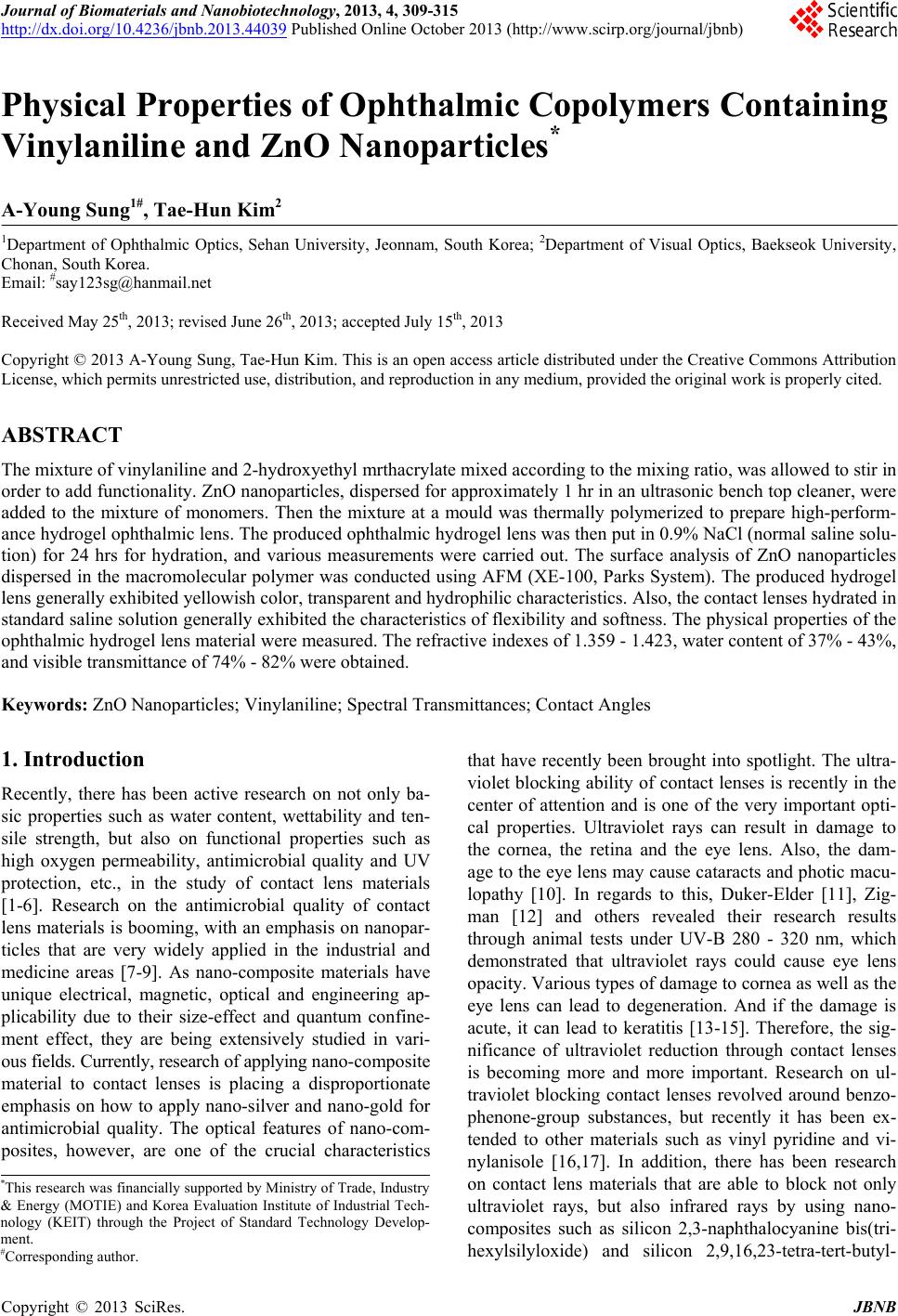 Journal of Biomaterials and Nanobiotechnology, 2013, 4, 309-315 http://dx.doi.org/10.4236/jbnb.2013.44039 Published Online October 2013 (http://www.scirp.org/journal/jbnb) 309 Physical Properties of Ophthalmic Copolymers Containing Vinylaniline and ZnO Nanoparticles* A-Young Sung1#, Tae-Hun Kim2 1Department of Ophthalmic Optics, Sehan University, Jeonnam, South Korea; 2Department of Visual Optics, Baekseok University, Chonan, South Korea. Email: #say123sg@hanmail.net Received May 25th, 2013; revised June 26th, 2013; accepted July 15th, 2013 Copyright © 2013 A-Young Sung, Tae-Hun Kim. This is an open access article distributed under the Creative Commons Attribution License, which permits unrestricted use, distribution, and reproduction in any medium, provided the original work is properly cited. ABSTRACT The mixture of vinylanilin e and 2-h yd roxyeth yl mrthacrylate mix ed accord ing to the mixing ratio, was allowed to stir in order to add functio nality. ZnO nanoparticles, dispersed for approximately 1 hr in an ultrasonic bench top cleaner, were added to the mixture of monomers. Then the mixture at a mould was thermally polymerized to prepare high-perform- ance hydrogel ophthalmic lens. The produced ophthalmic hydrogel lens was then put in 0.9% NaCl (normal saline solu- tion) for 24 hrs for hydration, and various measurements were carried out. The surface analysis of ZnO nanoparticles dispersed in the macromolecular polymer was conducted using AFM (XE-100, Parks System). The produced hydrogel lens generally exhibited yellowish color, transparent and hydrophilic characteristics. Also, the contact lenses hydrated in standard saline solu tion generally exhibited the ch aracteristics of flexibility and softness. The physical prop erties of the ophthalmic hydrogel lens material were measured. The refractive indexes of 1.359 - 1.423, water content of 37% - 43%, and visible transmittance of 74% - 82% were obtained. Keywords: ZnO Nanoparticles; Vinylaniline; Spectral Transmittances; Contact Angles 1. Introduction Recently, there has been active research on not only ba- sic properties such as water content, wettability and ten- sile strength, but also on functional properties such as high oxygen permeability, antimicrobial quality and UV protection, etc., in the study of contact lens materials [1-6]. Research on the antimicrobial quality of contact lens materials is booming, with an emphasis on nanopar- ticles that are very widely applied in the industrial and medicine areas [7-9]. As nano-composite materials have unique electrical, magnetic, optical and engineering ap- plicability due to their size-effect and quantum confine- ment effect, they are being extensively studied in vari- ous fields. Currently, research of applyi ng nano-composite material to contact lenses is placing a disproportionate emphasis on how to apply nano-silver and nano-gold for antimicrobial quality. The optical features of nano-com- posites, however, are one of the crucial characteristics that have recently been brought into spotlight. The ultra- violet blocking ability of contact lenses is recently in the center of attention and is one of the very important opti- cal properties. Ultraviolet rays can result in damage to the cornea, the retina and the eye lens. Also, the dam- age to the eye lens may cause cataracts and photic macu- lopathy [10]. In regards to this, Duker-Elder [11], Zig- man [12] and others revealed their research results through animal tests under UV-B 280 - 320 nm, which demonstrated that ultraviolet rays could cause eye lens opacity. Various types of damage to cornea as well as the eye lens can lead to degeneration. And if the damage is acute, it can lead to keratitis [13-15]. Therefore, the sig- nificance of ultraviolet reduction through contact lenses is becoming more and more important. Research on ul- traviolet blocking contact lenses revolved around benzo- phenone-group substances, but recently it has been ex- tended to other materials such as vinyl pyridine and vi- nylanisole [16,17]. In addition, there has been research on contact lens materials that are able to block not only ultraviolet rays, but also infrared rays by using nano- composites such as silicon 2,3-naphthalocyanine bis(tri- hexylsilyloxide) and silicon 2,9,16,23-tetra-tert-butyl- *This research was financially supported by Ministry of Trade, Industry & Energy (MOTIE) and Korea Evaluation Institute of Industrial Tech- nology (KEIT) through the Project of Standard Technology Develop- ment. #Corresponding author. Copyright © 2013 SciRes. JBNB 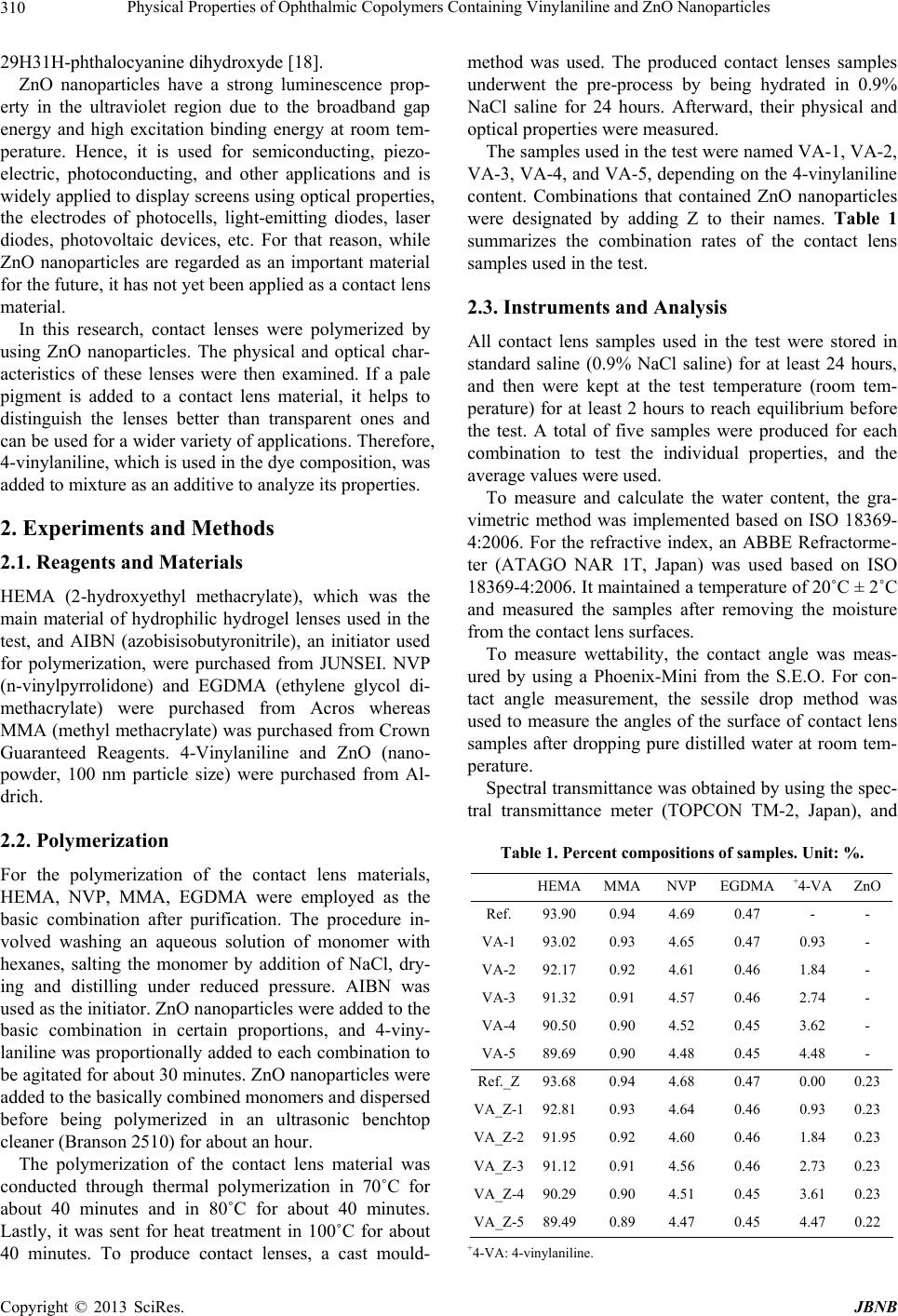 Physical Properties of Ophthalmic Copolymers Containing Vinylaniline and ZnO Nanoparticles 310 29H31H-p ht halocyanine dihy dr o xy de [1 8] . ZnO nanoparticles have a strong luminescence prop- erty in the ultraviolet region due to the broadband gap energy and high excitation binding energy at room tem- perature. Hence, it is used for semiconducting, piezo- electric, photoconducting, and other applications and is widely applied to disp lay screens using optical prop erties, the electrodes of photocells, light-emitting diodes, laser diodes, photovoltaic devices, etc. For that reason, while ZnO nanoparticles are regarded as an important material for the future, it has not yet been applied as a contact lens material. In this research, contact lenses were polymerized by using ZnO nanoparticles. The physical and optical char- acteristics of these lenses were then examined. If a pale pigment is added to a contact lens material, it helps to distinguish the lenses better than transparent ones and can be used for a wider variety of applications. Therefore, 4-vinylanilin e, which is used in the d ye comp osition , was added to mixture as an additive to analyze its properties. 2. Experiments and Methods 2.1. Reagents and Materials HEMA (2-hydroxyethyl methacrylate), which was the main material of hydrophilic hydrogel lenses used in the test, and AIBN (azobisisobutyronitrile), an initiator used for polymerization, were purchased from JUNSEI. NVP (n-vinylpyrrolidone) and EGDMA (ethylene glycol di- methacrylate) were purchased from Acros whereas MMA (methyl methacrylate) was purchased f rom Crown Guaranteed Reagents. 4-Vinylaniline and ZnO (nano- powder, 100 nm particle size) were purchased from Al- drich. 2.2. Polymerization For the polymerization of the contact lens materials, HEMA, NVP, MMA, EGDMA were employed as the basic combination after purification. The procedure in- volved washing an aqueous solution of monomer with hexanes, salting the monomer by addition of NaCl, dry- ing and distilling under reduced pressure. AIBN was used as the initiator. ZnO nanoparticles were added to the basic combination in certain proportions, and 4-viny- laniline was proportion ally added to each combination to be agitated for about 30 minutes. ZnO nanoparticles were added to the basically combined monomers and dispersed before being polymerized in an ultrasonic benchtop cleaner (Branson 2510) for about an hour. The polymerization of the contact lens material was conducted through thermal polymerization in 70˚C for about 40 minutes and in 80˚C for about 40 minutes. Lastly, it was sent for heat treatment in 100˚C for about 40 minutes. To produce contact lenses, a cast mould- method was used. The produced contact lenses samples underwent the pre-process by being hydrated in 0.9% NaCl saline for 24 hours. Afterward, their physical and optical properties were measured. The samples used in the test were named VA-1, VA-2, VA-3, VA-4, and VA-5, depend ing on the 4-vinylaniline content. Combinations that contained ZnO nanoparticles were designated by adding Z to their names. Table 1 summarizes the combination rates of the contact lens samples used in the test. 2.3. Instruments and Analysis All contact lens samples used in the test were stored in standard saline (0.9% NaCl saline) for at least 24 hours, and then were kept at the test temperature (room tem- perature) for at least 2 hours to reach equilibrium before the test. A total of five samples were produced for each combination to test the individual properties, and the average values we re used. To measure and calculate the water content, the gra- vimetric method was implemented based on ISO 18369- 4:2006. For the refractive index, an ABBE Refractorme- ter (ATAGO NAR 1T, Japan) was used based on ISO 18369-4:20 06. It maintained a temperatu re of 20˚C ± 2˚C and measured the samples after removing the moisture from the contact lens surfaces. To measure wettability, the contact angle was meas- ured by using a Phoenix-Mini from the S.E.O. For con- tact angle measurement, the sessile drop method was used to measure the angles of the surface of contact lens samples after dropping pure distilled water at room tem- perature. Spectral transmittance was obtained by using the spec- tral transmittance meter (TOPCON TM-2, Japan), and Table 1. Percent compositions of samples. Unit: %. HEMAMMANVP EGDMA +4-VA ZnO Ref. 93.90 0.94 4.69 0.47 - - VA-193.02 0.93 4.65 0.47 0.93 - VA-292.17 0.92 4.61 0.46 1.84 - VA-391.32 0.91 4.57 0.46 2.74 - VA-490.50 0.90 4.52 0.45 3.62 - VA-589.69 0.90 4.48 0.45 4.48 - Ref._Z93.68 0.94 4.68 0.47 0.00 0.23 VA_Z-192.81 0.93 4.64 0.46 0.93 0.23 VA_Z-291.95 0.92 4.60 0.46 1.84 0.23 VA_Z-391.12 0.91 4.56 0.46 2.73 0.23 VA_Z-490.29 0.90 4.51 0.45 3.61 0.23 VA_Z-589.49 0.89 4.47 0.45 4.47 0.22 +4-VA: 4-vinylaniline . Copyright © 2013 SciRes. JBNB  Physical Properties of Ophthalmic Copolymers Containing Vinylaniline and ZnO Nanoparticles 311 the transmittance of UV-B, UV-A and visible ray were represented in terms of percentage. To analyze the nano-particles contained in the poly- mers, an atomic force microscope (XE-100, Parks Sys- tem) and FE-SEM (JSM-7500F+EDS, Oxford) were used. 3. Result and Discussion 3.1. Polymerization and Production Basic combinations of contact lenses were used in the test, and the Ref. combination produced colorless and transparent contact lenses. Since it was hydrated in stan- dard saline for 24 hours, it sho wed generally flexible and soft properties. The combination with the addition of ZnO nanoparticles tended to result in pale white-colored transparent contact lenses. The combination to which 4-vinylaniline was added to the basic combination or the Ref. combination generated a high performance poly- merthat featured a transparent brown tint. Overall, the greater the proportion of added substances, the more visible their colors were. Since all the combinations were soaked in standard saline for 24 hours, they were all flexible and soft. After analyzing the surface conditions and the combi- nations with ZnO nanoparticles with an atomic force microscope, it was found that the particles of about 50 - 70 nm were evenly distributed. The analysis results of the atomic force microscope on hydrogel contact lenses containing ZnO nanoparticles and the photos of the manufactured contact lenses’ appearance and colors are shown in Figures 1-3. 3.2. Water Content and Refractive Index After measuring the water content of the produced con- tact lenses, it was revealed that the average water content of the Ref. that did not contain 4-vinylaniline and ZnO nanoparticles was 38.95%. This water content value is similar to normal hydrogel contact lenses. The average water contents of the VA combination to which 4-viny- laniline was added in different proportions were VA-1 (37.11%), VA-2 (35.72%), VA-3 (33.99%), VA-4 (33.18%), and VA-5 (31.10%). Overall, greater propor- tions of 4-vinylaniline tended to result in less water con- tent. It was deemed that the vinyl group that is suscepti- ble to polymerization played a role in attaining the hy- drophobic properties. The average water content of the Ref._Z combination made by adding the Ref. combination with ZnO nanopar- ticles was measured as 38.45%. This water content value is similar to normal hydrogel contact lenses, as well as the Ref. combination. The average water contents of the VA combination to which ZnO nanoparticles were added were VA_Z-1 (37.06%), VA_Z-2 (34.88%), VA_Z-3 Figure 1. Photograph of tinted hydrogel lens. (34.36%), VA_Z-4 (32.75%) and VA_Z-5 (30.62%). Overall, greater proportions of 4-vinylaniline tended to result in less water content. It was found that the varia- tion in water content induced by the addition of ZnO nanoparticles was not very significant. After measuring the refractive index of the produced contact lenses, the average refractive index for Ref. to which 4-vinylaniline and ZnO nanoparticles were not added was 1.4352. The average refractive index of the Ref. combination to which 4-vinylaniline was added in different proportions fell into the range of 1.4472 - 1.4780. In general, greater proportions of 4-vinylaniline tended to result in greater refractive index. The average water content of the Ref._Z combination made by adding the Ref. combination with ZnO nanoparticle fell into the range of 1.4450 - 1.4780. Just like VA combination, greater proportions of 4-viny- laniline resulted in greater refractive index. It was found that the variation in refractive index by the addition of ZnO nanoparticles was not very significant. Table 2 shows the water content and refractive index of each sample. 3.3. Wettability As the contact angle was measured to evaluate the wet- tability of the produced contact lenses, it was found that the average contact angle for the Ref. without 4-viny- laniline and ZnO nanoparticles was 46.96˚. The average contact angle of the Ref._Z combination made by adding the Ref. combination with ZnO nanoparticles was meas- ured as low as 42.02˚, indicating that the additio n of ZnO nanoparticles influenced the contact angle. The average contact angles of the VA combination to which 4-viny- laniline was added in different proportions were VA-1 (54.95˚), VA-2 (58.57˚), VA-3 (64.68˚), VA-4 (71.45˚), and VA-5 (76.67˚). In general, greater proportions of 4-vinylaniline tended to result in larger contact angles, leading to a drop in wettability. This was apparently caused by the hydrophobic properties of 4-vinylaniline, which blocked the wettability on the surface. The average contact angles of the VA_Z combination Copyright © 2013 SciRes. JBNB 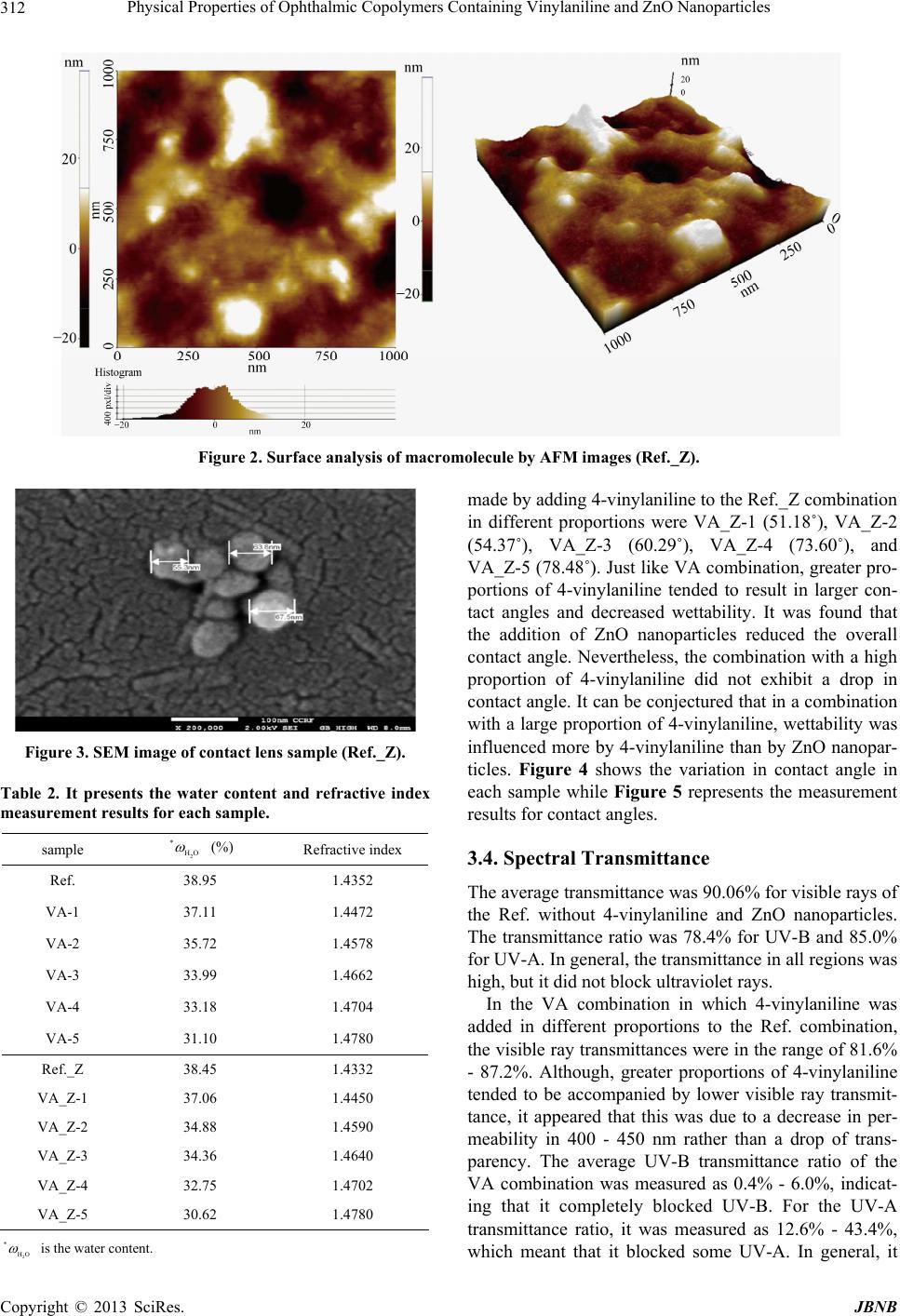 Physical Properties of Ophthalmic Copolymers Containing Vinylaniline and ZnO Nanoparticles Copyright © 2013 SciRes. JBNB 312 Figure 2. Surface analysis of macromolecule by AFM images (Ref._Z). made by adding 4-vin ylaniline to th e Ref._Z co mbination in different proportions were VA_Z-1 (51.18˚), VA_Z-2 (54.37˚), VA_Z-3 (60.29˚), VA_Z-4 (73.60˚), and VA_Z-5 (78.48˚). Just like VA combination, greater pro- portions of 4-vinylaniline tended to result in larger con- tact angles and decreased wettability. It was found that the addition of ZnO nanoparticles reduced the overall contact angle. Nevertheless, the combination with a high proportion of 4-vinylaniline did not exhibit a drop in contact angle. It can be conjectured that in a combination with a large proportion of 4-vinylaniline, wettability was influenced more by 4-vin ylaniline than by ZnO nanopar- ticles. Figure 4 shows the variation in contact angle in each sample while Figure 5 represents the measurement results for contact angles. Figure 3. SEM image of contact lens sample (Ref._Z). Table 2. It presents the water content and refractive index measuremen t results for each sample. sample 2 * HO (%) Refractive index Ref. 38.95 1.4352 VA-1 37.11 1.4472 VA-2 35.72 1.4578 VA-3 33.99 1.4662 VA-4 33.18 1.4704 VA-5 31.10 1.4780 Ref._Z 38.45 1.4332 VA_Z-1 37.06 1.4450 VA_Z-2 34.88 1.4590 VA_Z-3 34.36 1.4640 VA_Z-4 32.75 1.4702 VA_Z-5 30.62 1.4780 3.4. Spectral Transmittance The average transmittance was 90.06% for visible rays of the Ref. without 4-vinylaniline and ZnO nanoparticles. The transmittance ratio was 78.4% for UV-B and 85.0% for UV-A. In general, the transmittance in all regions was high, but it did not block ul t r aviolet rays . In the VA combination in which 4-vinylaniline was added in different proportions to the Ref. combination, the visible ray transmittances were in the range of 81.6% - 87.2%. Although, greater proportions of 4-vinylaniline tended to be accompanied by lower visible ray transmit- tance, it appeared that this was due to a decrease in per- meability in 400 - 450 nm rather than a drop of trans- parency. The average UV-B transmittance ratio of the VA combination was measured as 0.4% - 6.0%, indicat- ing that it completely blocked UV-B. For the UV-A transmittance ratio, it was measured as 12.6% - 43.4%, which meant that it blocked some UV-A. In general, it 2 * HO is the water content. 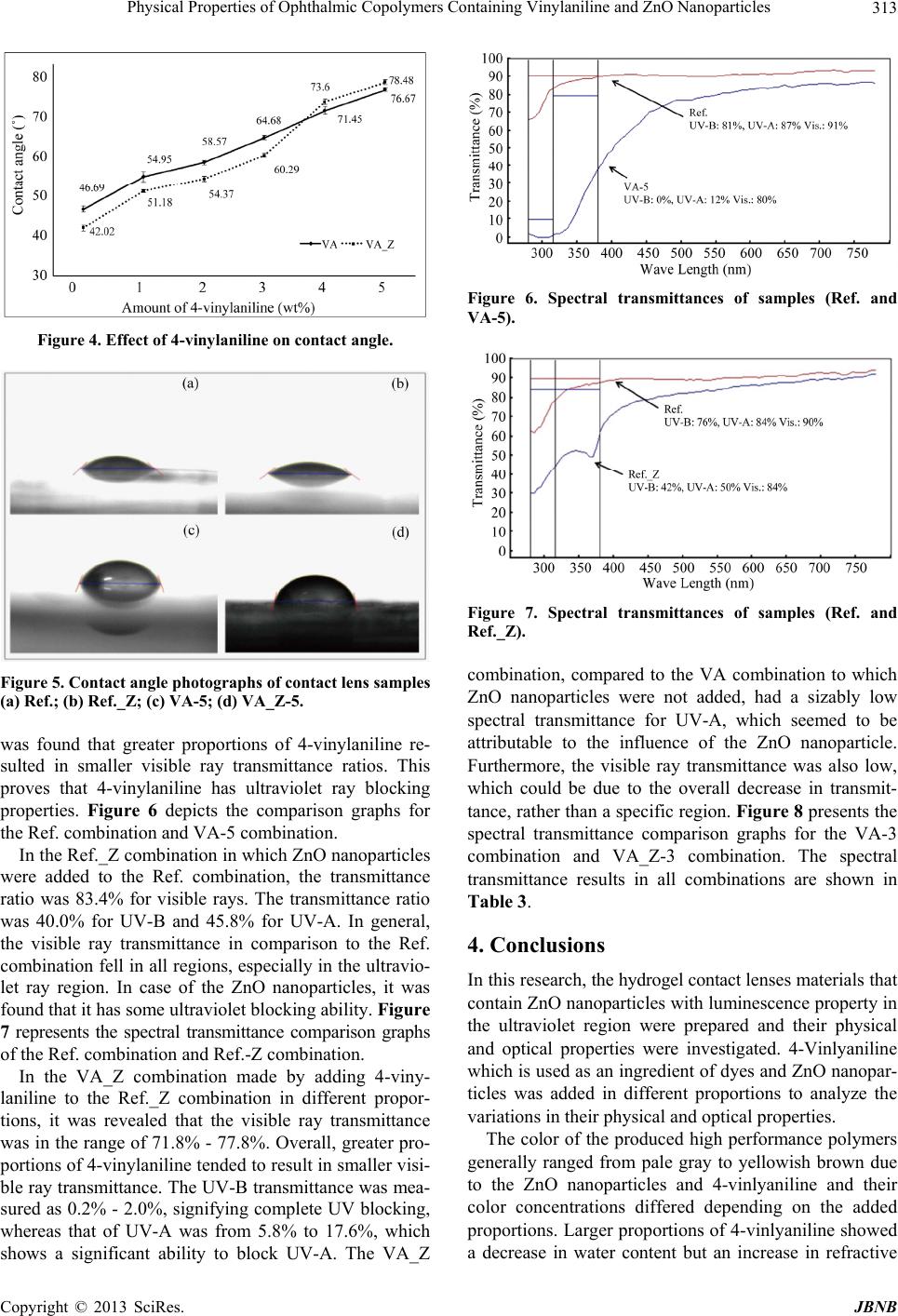 Physical Properties of Ophthalmic Copolymers Containing Vinylaniline and ZnO Nanoparticles 313 Figure 4. Effect of 4-vinylaniline on contact angle. Figure 5. Contact angle photographs of contact lens samples (a) Ref.; (b) Ref._Z; (c) VA-5; (d) VA_Z-5. was found that greater proportions of 4-vinylaniline re- sulted in smaller visible ray transmittance ratios. This proves that 4-vinylaniline has ultraviolet ray blocking properties. Figure 6 depicts the comparison graphs for the Ref. combination and VA-5 combination. In the Ref._Z combinatio n in which ZnO nanoparticles were added to the Ref. combination, the transmittance ratio was 83.4% for visible rays. The transmittance ratio was 40.0% for UV-B and 45.8% for UV-A. In general, the visible ray transmittance in comparison to the Ref. combination fell in all reg ions, especially in the ultravio- let ray region. In case of the ZnO nanoparticles, it was found that it has some ultraviolet block ing ability. Figure 7 represents the spectral transmittance comparison graphs of the Ref. combination and Ref.-Z combination. In the VA_Z combination made by adding 4-viny- laniline to the Ref._Z combination in different propor- tions, it was revealed that the visible ray transmittance was in the range of 71.8% - 77.8%. Overall, greater pro- portions of 4-vinylanilin e tended to result in smaller visi- ble ray transmittance. The UV-B transmittance was mea- sured as 0.2% - 2.0%, signifying complete UV blocking, whereas that of UV-A was from 5.8% to 17.6%, which shows a significant ability to block UV-A. The VA_Z Figure 6. Spectral transmittances of samples (Ref. and VA-5). Figure 7. Spectral transmittances of samples (Ref. and Ref._Z). combination, compared to the VA combination to which ZnO nanoparticles were not added, had a sizably low spectral transmittance for UV-A, which seemed to be attributable to the influence of the ZnO nanoparticle. Furthermore, the visible ray transmittance was also low, which could be due to the overall decrease in transmit- tance, rather than a specific region. Figure 8 presents the spectral transmittance comparison graphs for the VA-3 combination and VA_Z-3 combination. The spectral transmittance results in all combinations are shown in Table 3. 4. Conclusions In th i s r es e arch , the hydrogel contact lens es mat er i al s t h at contain ZnO nanoparticles with luminescence property in the ultraviolet region were prepared and their physical and optical properties were investigated. 4-Vinlyaniline which is used as an ingredient of dyes and ZnO nanopar- ticles was added in different proportions to analyze the variations in their physical and optical properties. The color of the produced high performance polymers generally ranged from pale gray to yellowish brown due to the ZnO nanoparticles and 4-vinlyaniline and their color concentrations differed depending on the added proportions. Larger proportion s of 4-vinlyaniline showed a decrease in water content but an increase in refractive Copyright © 2013 SciRes. JBNB  Physical Properties of Ophthalmic Copolymers Containing Vinylaniline and ZnO Nanoparticles 314 Figure 8. Spectral transmittances of samples (VA-3 and VA_Z-3). Table 3. Spectral transmittances of samples. sample UV-B UV-A Vis. Ref. 78.4 85.0 90.6 VA-1 6.0 43.4 87.2 VA-2 2.0 28.6 85.4 VA-3 1.0 22.8 85.2 VA-4 1.0 21.4 83.6 VA-5 0.4 12.6 81.6 Ref._Z 40.0 45.8 83.4 VA_Z-1 2.0 17.6 77.8 VA_Z-2 0.6 11.0 74.0 VA_Z-3 0.4 11.0 76.8 VA_Z-4 0.2 6.8 73.8 VA_Z-5 0.2 5.8 71.8 index. And it was uncovered that the addition of ZnO nanoparticles played a negligible role. The wettability of contact lens tended to diminish with the increase in the proportion of 4-vinlyaniline. The addition of ZnO nano- particle was also shown to exert some influence over contact angle. In terms of spectral transmittance, the addition of ZnO nanoparticles led to the decreasing in transmittance ratio in the ultraviolet region. If 4-vinlyaniline was added, it also reduced the transmittance ratio in the ultraviolet region. It is expected that the results would contribute to a wider application of contact lenses containing ZnO nano- particles which are to be used as ultraviolet ray blocking contact lenses, and aniline-group materials can be employ- ed to show pale colors in hydrophilic lenses and utilized as an ultraviolet ray blocking contact lens material. REFERENCES [1] T. H. Kim, K. H. Ye and A. Y. Sung, “UV-Blocking Ef- fect of Ophthalmic Material Containing Benzophenone,” Journal of the Korean Chemical Society, Vol. 53, No. 3, 2009, pp. 391-398. http://dx.doi.org/10.5012/jkcs.2009.53.3.391 [2] K. Diduch, R. Wubbenhorst and S. Kucharski, “Photo- current Generation of Bi-Functional Carbazole Contain- ing Polymers,” Synthetic Metals, Vol. 139, No. 2, 2003, pp. 515-520. http://dx.doi.org/10.1016/S0379-6779(03)00352-7 [3] V. A. Soloukhin, W. Postumus, J. C. M. Brokken-Zijp and J. Loos, “Mechanical Properties of Silica-(Meth)- Acrylate Hybrid Coatings on Polycarbonate Substrate,” Polymer, Vol. 43, No. 23, 2002, pp. 6169-6181. http://dx.doi.org/10.1016/S0032-3861(02)00542-6 [4] T. H. Kim and A. Y. Sung, “Copolymerization and Con- tact Lens Application of HEMA-Substituted Polyphos- phazene,” Journal of the Korean Chemical Society, Vol. 53, No. 3, 2009, pp. 340-344. http://dx.doi.org/10.5012/jkcs.2009.53.3.340 [5] T. H. Kim, K. H. Ye, Y. S. Kwon and A. Y. Sung, “Study on the Silicone Contact Lens Using AA and BMA,” Jour- nal of the Korean Ophthalmic Optics Society, Vol. 11, No. 3, 2006. pp. 259-265. [6] K. Vimala, M. M. Yallapu, K. Varaprasad, N. Narayana Reddy, S. Ravindra, N. S. Naidu and K. MohanaRaju, “Fabrication of Curcumin Encapsulated Chitosan-PVA Silver Nanocomposite Films for Improved Antimicrobial Activity” Journal of Biomaterials and Nanobiotechnol- ogy, Vol. 2, No. 1, 2011, pp. 55-64. http://dx.doi.org/10.4236/jbnb.2011.21008 [7] K. H. Ye, S. H. Choi and A. Y. Sung, “Study on the An- tibiosis and Physical Properties of Copolymer Containing Silver,” Journal of the Korean Chemical Society, Vol. 53, No. 3, 2009, pp. 562-546. [8] K. H. Ye and A. Y. Sung, “Synthesis of Poly mer Materi- als Containing Platinum Nanoparticles and Their Appli- cation for Contact Lenses,” Journal of the Korean Che- mical Society, Vol. 54, No. 1, 2010, pp. 99-104. http://dx.doi.org/10.5012/jkcs.2010.54.01.099 [9] K. H. Ye and A. Y. Sung, “Study on the Synthesis and Physical Properties of Ophthalmic Polymer Containing Gold Nanoparticles,” Journal of the Korean Chemical Society, Vol. 54, No. 2, 2010, pp. 222-227. http://dx.doi.org/10.5012/jkcs.2010.54.02.222 [10] R. W. Young, “Solar Radiation and Age-Related Macular Degeneration,” Survey of Ophthalmology, Vol. 32, No. 4, 1998, pp. 252-269. http://dx.doi.org/10.1016/0039-6257(88)90174-9 [11] W. S. Duke-Elder and P. M. Duke-Elder, “A Histological Study on the Action of Short-Waved Light upon the Eye, with a Note on ‘Inclusion Bodies’,” British Journal of Ophthalmology, Vol. 13, No. 1, 1929, pp. 1-37. http://dx.doi.org/10.1136/bjo.13.1.1 [12] S. Zigman, T. Yulo and J. Schultz, “Cataract Induction in Mice Exposed to near UV Light,” Ophthalmic Research, Vol. 6, No. 2-4, 1974, pp. 259-270. http://dx.doi.org/10.1159/000264710 [13] M. Kennedy, K. H. Kim, B. Harten, et al., “Ultraviolet Irradiation Induces the Production of Multiple Cytokines by Human Corneal Cells,” Investigative Ophthalmology Copyright © 2013 SciRes. JBNB 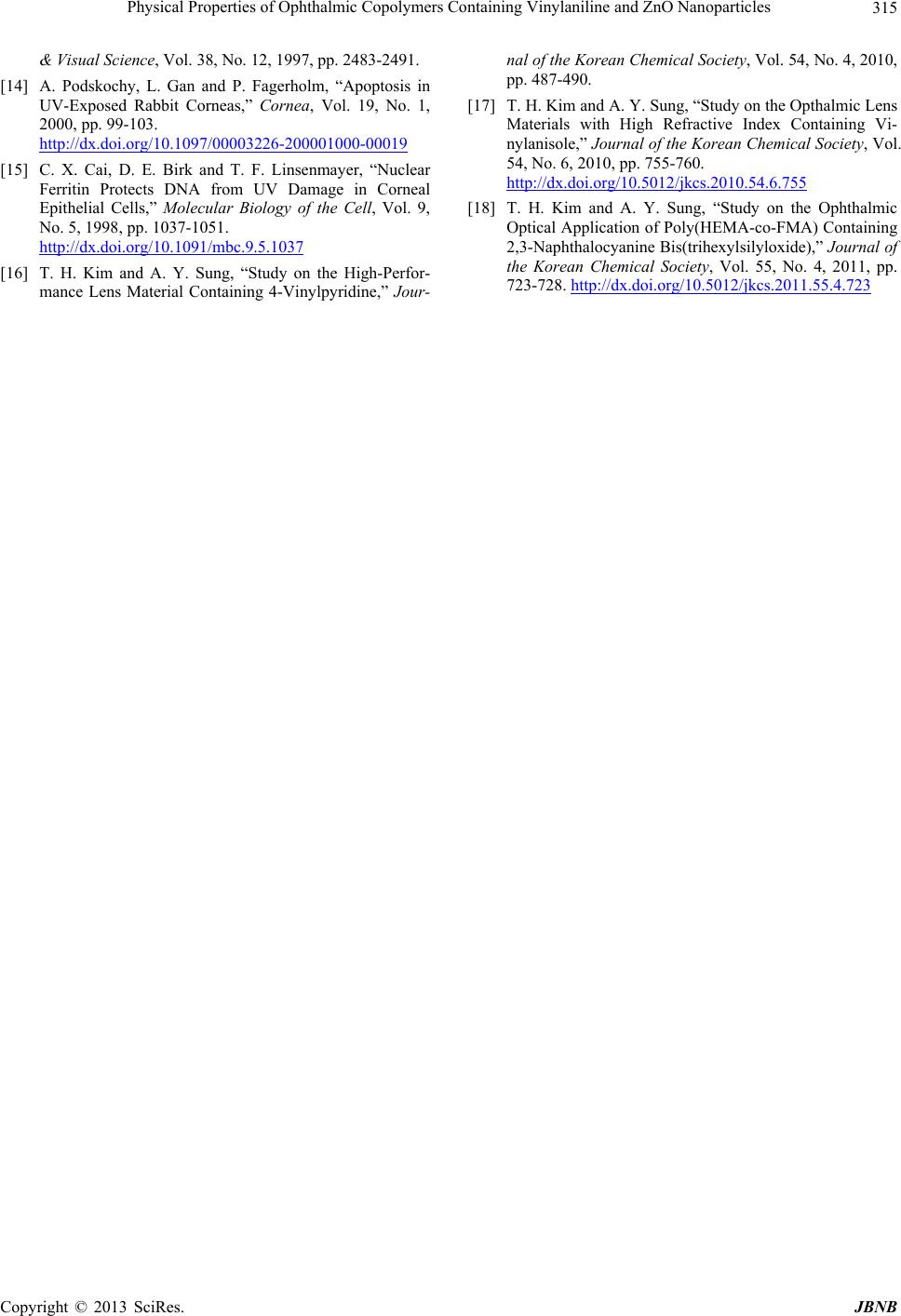 Physical Properties of Ophthalmic Copolymers Containing Vinylaniline and ZnO Nanoparticles Copyright © 2013 SciRes. JBNB 315 & Visual Science, Vol. 38, No. 12, 1997, pp. 2483-2491. [14] A. Podskochy, L. Gan and P. Fagerholm, “Apoptosis in UV-Exposed Rabbit Corneas,” Cornea, Vol. 19, No. 1, 2000, pp. 99-103. http://dx.doi.org/10.1097/00003226-200001000-00019 [15] C. X. Cai, D. E. Birk and T. F. Linsenmayer, “Nuclear Ferritin Protects DNA from UV Damage in Corneal Epithelial Cells,” Molecular Biology of the Cell, Vol. 9, No. 5, 1998, pp. 1037-1051. http://dx.doi.org/10.1091/mbc.9.5.1037 [16] T. H. Kim and A. Y. Sung, “Study on the High-Perfor- mance Lens Material Containing 4-Vinylpyridine,” Jour- nal of the Korean Chemical Society, Vol. 54, No. 4, 2010, pp. 487-490. [17] T. H. Kim and A. Y. Sung, “Study on the Opthalmic Lens Materials with High Refractive Index Containing Vi- nylanisole,” Journal of the Korean Chemical Society, Vol. 54, No. 6, 2010, pp. 755-760. http://dx.doi.org/10.5012/jkcs.2010.54.6.755 [18] T. H. Kim and A. Y. Sung, “Study on the Ophthalmic Optical Application of Poly(HEMA-co-FMA) Containing 2,3-Naphthalocyanine Bis(trihexylsilyloxide),” Journal of the Korean Chemical Society, Vol. 55, No. 4, 2011, pp. 723-728. http://dx.doi.org/10.5012/jkcs.2011.55.4.723
|